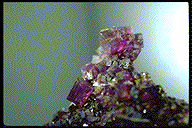THE
PHYSICAL CHARACTERISTICS
OF MINERALS
Minerals can be only identified absolutely by x-ray analysis and chemical tests. The x-ray analysis determines the structure of the mineral and the chemical tests determine the composition of the mineral. Structure and composition are the defining marks of a mineral.
Unfortunately for the average collector, these tests require expensive equipment, expert know-how and often destroy the specimen. Fortunately, both structure and composition affect certain physical properties. It is through the proper use of these properties that minerals can reliably be identified.
The best physical property is one that will give a unique result for a mineral and will always give the same result, again and again, for any and every specimen of that mineral. This is of course idealized. Mineralogists are usually happy to have a property that simply is consistent in providing the same result for every specimen of a certain mineral. Hopefully, this property also has a good range of possible results so that two similar minerals might stand a good chance of having different results. It would be nice if every mineral had their own special test that we could name after them such as the "Fluorite Test" for example. But they usually don't, so we must catalog all the results of several known physical property tests and hope that a collector can find enough positive (or diagnostically negative) results out of these to identify an unknown mineral.
These are the physical properties most useful for mineral identification:
Other Important Properties and Characteristics:










